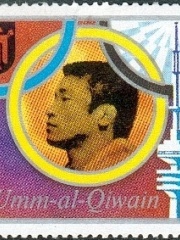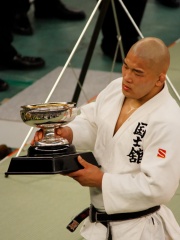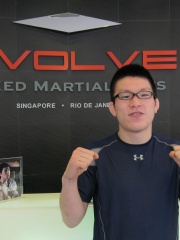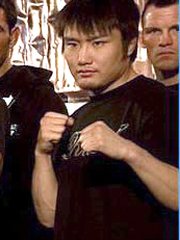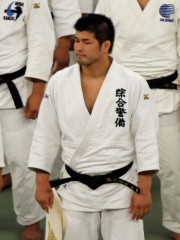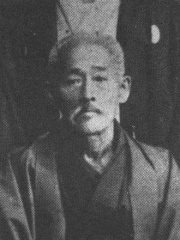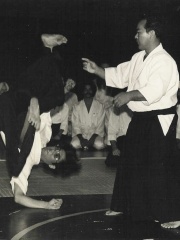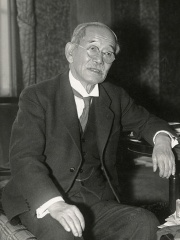
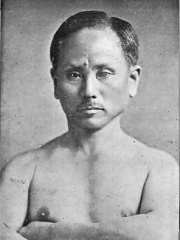

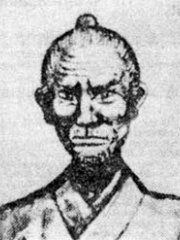
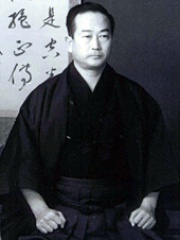
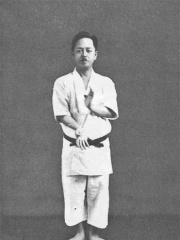
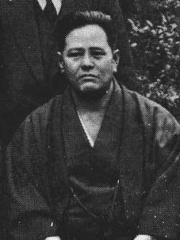
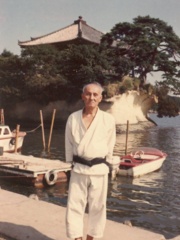
The Most Famous
MARTIAL ARTS from Japan
This page contains a list of the greatest Japanese Martial Arts. The pantheon dataset contains 179 Martial Arts, 31 of which were born in Japan. This makes Japan the birth place of the 2nd most number of Martial Arts.
Top 10
The following people are considered by Pantheon to be the top 10 most legendary Japanese Martial Arts of all time. This list of famous Japanese Martial Arts is sorted by HPI (Historical Popularity Index), a metric that aggregates information on a biography's online popularity. Visit the rankings page to view the entire list of Japanese Martial Arts.

1. Kanō Jigorō (1860 - 1938)
With an HPI of 75.46, Kanō Jigorō is the most famous Japanese Martial Arts. His biography has been translated into 53 different languages on wikipedia.
Kanō Jigorō (嘉納 治五郎; 10 December 1860 – 4 May 1938) was a Japanese martial artist, educator, politician, and the founder of judo. Judo was one of the first Japanese martial arts to gain widespread international recognition, and the first to become an official Olympic sport. Pedagogical innovations attributed to Kanō include the use of black and white belts, and the introduction of dan ranking to show the relative ranking among members of a martial-art-style. Well-known mottoes attributed to Kanō include "maximum efficiency minimal effort" (精力善用, seiryoku zen'yō) and "mutual welfare and benefit" (自他共栄, jita kyōei). In his professional life, Kanō was an educator and a promoter of multiple sports in Japan, including swimming, athletics, weightlifting and other forms of physical education. Aside from judo, he is considered by some to be the originator of modern strength training in Japan. He also helped Gichin Funakoshi and other masters to introduce and systematize karate in the country. He was also a high member of the Dai Nippon Butoku Kai martial arts organization, and played a key role in making judo and kendo part of the Japanese public school programs. His nephew Kenji Kanō, founder of the first western boxing club in Japan, was also influenced by him. Important postings included serving as director of primary education for the Ministry of Education (文部省, Monbushō) from 1898 to 1901, and as president of Tokyo Higher Normal School from 1900 until 1920. He was the educational founder of Nada High School in Kobe, Japan. Accomplishments included being the first Asian member of the International Olympic Committee (IOC) (serving from 1909 to 1938), officially representing Japan at most Olympic Games held between 1912 and 1936, and serving as a leading spokesman for Japan's bid for the 1940 Olympic Games. His official honors and decorations included the First Order of Merit and Grand Order of the Rising Sun and the Third Imperial Degree. Kanō was inducted as the first member of the International Judo Federation (IJF) Hall of Fame on 14 May 1999.

2. Gichin Funakoshi (1868 - 1957)
With an HPI of 74.41, Gichin Funakoshi is the 2nd most famous Japanese Martial Arts. His biography has been translated into 45 different languages.
Gichin Funakoshi (船越 義珍, Funakoshi Gichin; November 10, 1868 – April 26, 1957) was the founder of Shotokan karate. He is known as a "father of modern karate". Following the teachings of Anko Itosu and Anko Asato, he was one of the Okinawan karate masters who introduced karate to the Japanese mainland in 1922, following its earlier introduction by his teacher Itosu. He taught karate at various Japanese universities and became honorary head of the Japan Karate Association upon its establishment in 1949. In addition to being a karate master, Funakoshi was an avid poet and philosopher. His son, Gigō Funakoshi, is widely credited with developing the foundation of the modern karate Shotokan style.

3. Morihei Ueshiba (1883 - 1969)
With an HPI of 74.07, Morihei Ueshiba is the 3rd most famous Japanese Martial Arts. His biography has been translated into 54 different languages.
Morihei Ueshiba (植芝 盛平, Ueshiba Morihei; December 14, 1883 – April 26, 1969) was a Japanese martial artist and founder of the martial art of aikido. He is often referred to as "the founder" Kaiso (開祖) or Ōsensei (大先生/翁先生), "Great Teacher". The son of a landowner from Tanabe, Ueshiba studied a number of martial arts in his youth, and served in the Japanese Army during the Russo-Japanese War. After being discharged in 1907, he moved to Hokkaido as the head of a pioneer settlement; here he met and studied with Takeda Sōkaku, the headmaster of Daitō-ryū Aiki-jūjutsu. On leaving Hokkaido in 1919, Ueshiba joined the Ōmoto-kyō movement, a Shinto sect, in Ayabe, where he served as a martial arts instructor and opened his first dojo. He accompanied the head of the Ōmoto-kyō group, Onisaburo Deguchi, on an expedition to Mongolia in 1924, where they were captured by Chinese troops and returned to Japan. The following year, he had a profound spiritual experience, stating that, "a golden spirit sprang up from the ground, veiled my body, and changed my body into a golden one." After this experience, his martial arts technique became gentler, with a greater emphasis on the control of ki. Ueshiba moved to Tokyo in 1926, where he set up what would become the Aikikai Hombu Dojo. By this point he was comparatively famous in martial arts circles, and taught at this dojo and others around Japan, including in several military academies. In the aftermath of World War II the Hombu dojo was temporarily closed, but Ueshiba had by this point left Tokyo and retired to Iwama, and he continued training at the dojo he had set up there. From the end of the war until the 1960s, he worked to promote aikido throughout Japan and abroad. He died from liver cancer in 1969. After Ueshiba's death, aikido continued to be promulgated by his students (many of whom became noted martial artists in their own right). It is now practiced around the world.

4. Matsumura Sōkon (1809 - 1899)
With an HPI of 65.60, Matsumura Sōkon is the 4th most famous Japanese Martial Arts. His biography has been translated into 17 different languages.
Sōkon Matsumura (松村 宗棍, Matsumura Sōkon) was one of the original karate masters of Okinawa. The years of his lifespan are reported variously as 1809–1901 or 1798–1890 or 1809–1896 or 1800–1892. However, the dates on the plaque at Matsumura's tomb, put there by Matsumura's family, clearly state that he was born in 1809 and died in 1899 at approximately the age of 90 years old.
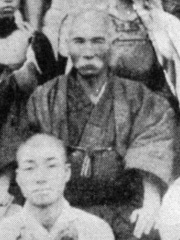
5. Ankō Itosu (1831 - 1915)
With an HPI of 63.57, Ankō Itosu is the 5th most famous Japanese Martial Arts. His biography has been translated into 20 different languages.
Ankō Itosu (糸洲 安恒, Okinawan: Ichiji Ankō; Japanese: Itosu Ankō, 1831 – 11 March 1915) is considered by many the father of modern karate. This title is also often given to Gichin Funakoshi because of the latter spreading karate throughout Japan.

6. Masatoshi Nakayama (1913 - 1987)
With an HPI of 63.34, Masatoshi Nakayama is the 6th most famous Japanese Martial Arts. His biography has been translated into 23 different languages.
Masatoshi Nakayama (中山 正敏, Nakayama Masatoshi; April 13, 1913 – April 15, 1987)[a] was an internationally famous Japanese master of Shotokan karate. He helped establish the Japan Karate Association (JKA) in 1949, and wrote many textbooks on karate, which served to popularize his martial art. For almost 40 years, until his death in 1987, Nakayama worked to spread Shotokan karate around the world. He was the first master in Shotokan history to attain the rank of 9th dan while alive, and was posthumously awarded the rank of 10th dan.

7. Kenwa Mabuni (1889 - 1952)
With an HPI of 62.64, Kenwa Mabuni is the 7th most famous Japanese Martial Arts. His biography has been translated into 20 different languages.
Kenwa Mabuni (摩文仁 賢和, Mabuni Kenwa; 14 November 1889 - 23 May 1952) was one of the first karateka to teach karate in mainland Japan and is credited as developing the style known as Shitō-ryū. Originally, he chose the name Hanko-ryu, literally "half-hard style", to imply that the style used both hard and soft techniques. Finally, Mabuni chose Shito-ryu, the first characters of the names Itosu and Higaonna, his two primary teachers.

8. Chōjun Miyagi (1888 - 1953)
With an HPI of 62.30, Chōjun Miyagi is the 8th most famous Japanese Martial Arts. His biography has been translated into 19 different languages.
Chōjun Miyagi (宮城 長順, Miyagi Chōjun; April 25, 1888 – October 8, 1953) was an Okinawan martial artist who founded the Gōjū-ryū school of karate by blending Okinawan and Chinese influences.

9. Hironori Ōtsuka (1892 - 1982)
With an HPI of 60.93, Hironori Ōtsuka is the 9th most famous Japanese Martial Arts. His biography has been translated into 16 different languages.
Hironori Ōtsuka (大塚 博紀, Ōtsuka Hironori; June 1, 1892 – January 29, 1982)[a] was a Japanese master of karate who created the Wadō-ryū style of karate. He was the first Grand Master of Wadō-ryū karate, and received high awards within Japan for his contributions to karate.
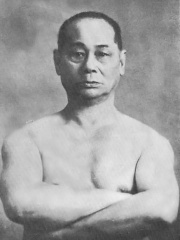
10. Motobu Chōki (1870 - 1944)
With an HPI of 60.84, Motobu Chōki is the 10th most famous Japanese Martial Arts. His biography has been translated into 17 different languages.
Motobu Chōki (本部 朝基; April 5, 1870 – April 15, 1944) was an Okinawan karate master and founder of Motobu-ryū. He was born into a branch of the Ryukyuan royal family, and at the age of 12, he and his older brother Motobu Chōyū were invited by Ankō Itosu to be taught karate. Motobu also studied karate under Sakuma, Matsumura Sōkon, and Kōsaku Matsumora. He excelled especially in kumite and was already known throughout Okinawa in his twenties. As he grew up, he came to be regarded as the best in Okinawa in terms of practical karate techniques. He is reported to have been very agile, which gained him the nickname Motobu no Saru ("Motobu the Monkey"). Motobu later moved to mainland Japan, and at the age of 52, he beat a foreign boxer in Kyoto, Japan, and his name became instantly known throughout the country. He distanced himself from the modernization trend in karate, focusing only on kata Naihanchi and concentrating on kumite practice.
People
Pantheon has 31 people classified as Japanese martial arts born between 1809 and 1992. Of these 31, 14 (45.16%) of them are still alive today. The most famous living Japanese martial arts include Takao Kawaguchi, Toyokazu Nomura, and Kazuhiro Ninomiya. The most famous deceased Japanese martial arts include Kanō Jigorō, Gichin Funakoshi, and Morihei Ueshiba. As of April 2024, 4 new Japanese martial arts have been added to Pantheon including Takanori Gomi, Katsuhiko Nagata, and Chiyori Masuchi.
Living Japanese Martial Arts
Go to all RankingsTakao Kawaguchi
1950 - Present
HPI: 55.26
Toyokazu Nomura
1949 - Present
HPI: 54.37
Kazuhiro Ninomiya
1946 - Present
HPI: 51.80
Yoshiyuki Matsuoka
1957 - Present
HPI: 48.53
Satoshi Ishii
1986 - Present
HPI: 45.47
Shinya Aoki
1983 - Present
HPI: 45.20
Takanori Gomi
1978 - Present
HPI: 44.69
Katsuhiko Nagata
1973 - Present
HPI: 43.56
Kōsei Inoue
1978 - Present
HPI: 43.52
Natsumi Tsunoda
1992 - Present
HPI: 41.32
Chiyori Masuchi
1970 - Present
HPI: 40.90
Hiroshi Izumi
1982 - Present
HPI: 39.37
Deceased Japanese Martial Arts
Go to all RankingsKanō Jigorō
1860 - 1938
HPI: 75.46
Gichin Funakoshi
1868 - 1957
HPI: 74.41
Morihei Ueshiba
1883 - 1969
HPI: 74.07
Matsumura Sōkon
1809 - 1899
HPI: 65.60
Ankō Itosu
1831 - 1915
HPI: 63.57
Masatoshi Nakayama
1913 - 1987
HPI: 63.34
Kenwa Mabuni
1889 - 1952
HPI: 62.64
Chōjun Miyagi
1888 - 1953
HPI: 62.30
Hironori Ōtsuka
1892 - 1982
HPI: 60.93
Motobu Chōki
1870 - 1944
HPI: 60.84
Higaonna Kanryō
1853 - 1916
HPI: 60.75
Koichi Tohei
1920 - 2011
HPI: 59.44
Newly Added Japanese Martial Arts (2025)
Go to all RankingsTakanori Gomi
1978 - Present
HPI: 44.69
Katsuhiko Nagata
1973 - Present
HPI: 43.56
Chiyori Masuchi
1970 - Present
HPI: 40.90
Noriko Narazaki
1972 - Present
HPI: 39.36
Overlapping Lives
Which Martial Arts were alive at the same time? This visualization shows the lifespans of the 14 most globally memorable Martial Arts since 1700.


